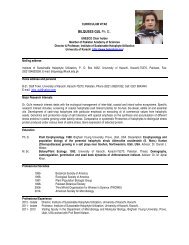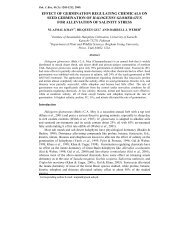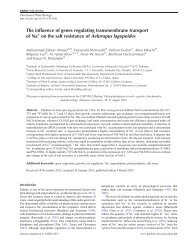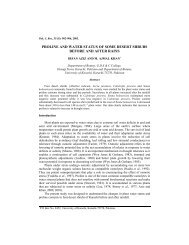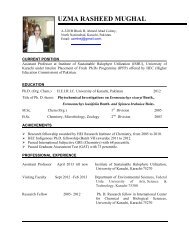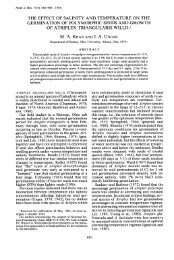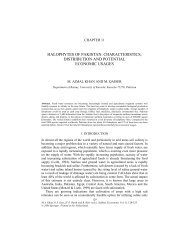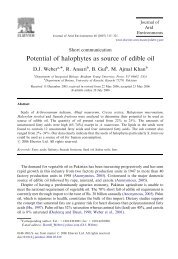Halophytes as Medicinal Plants - ResearchGate
Halophytes as Medicinal Plants - ResearchGate
Halophytes as Medicinal Plants - ResearchGate
You also want an ePaper? Increase the reach of your titles
YUMPU automatically turns print PDFs into web optimized ePapers that Google loves.
334 340 338<br />
Urbanisation, Land Use, Land Degradation and Environment<br />
Withania somnifera (L.) Dunal are useful for treating leucorrhoea (Qureshi and<br />
Bhatti, 2008; Savithramma et al., 2007; Hammiche and Maiza, 2006; Hussain et al.,<br />
2008). Fruit decoctions of Capparis decidua Forssk. (Ilahi, 2008) and Salvadora<br />
oleoides Decne. (Shafi et al., 2001) are used <strong>as</strong> aphrodisiac.<br />
The whole plant decoctions from Tribulus terrestris L. are used <strong>as</strong> a potent<br />
medicine to treat Spermatorrhoea (Hussain et al. 2008). A small quantity of<br />
Euphorbia caducifolia Haines latex taken orally by males before sexual intercourse is<br />
reputed to incre<strong>as</strong>e prowess (Goodman & Ghafoor, 1992). Ground roots of<br />
Achyranthes <strong>as</strong>pera L. are used traditionally to relieve labor discomfort and allow<br />
e<strong>as</strong>e of delivery (Qureshi and Bhatti, 2008).<br />
Aerial parts of Amaranthus virdis Linn. are frequently utilized in the treatment<br />
of urinary tract infections especially for kidney stones and painful urination (Qureshi<br />
and Bhatti, 2008). The plant is boiled in a pot until soft and eaten for dysuria. Oral<br />
decoctions of Alhagi maurorum Medic. are considered to have diuretic properties<br />
(Ilahi 2008). Infusion of Corchorus depressus (L.) Stocks are used to relieve irritation<br />
and pain during urination and provide relief from heat stroke in summer (Goodman &<br />
Ghafoor, 1992).<br />
OTHER MEDICAL CONDITIONS<br />
Leaf infusions of Atriplex stocksii Boiss. are used to treat jaundice and other<br />
liver disorders (Qureshi et al. 2009). Leaf decoctions of Aerva javanica (Burm. f.)<br />
Juss. ex J.A. Schultes are also used against jaundice while oral administration also<br />
cures yellow fever (Qureshi and Bhatti 2008, Hammiche and Maiza 2006). Powdered<br />
plant material of Glinus lotoides L. is useful <strong>as</strong> a blood purifier (Qureshi and Bhatti<br />
2008) and a major cure for pimples, boils, skin discoloration, jaundice, headaches,<br />
drowsiness, wrinkles and premature aging. Citrullus colocynthis L. is widely used to<br />
treat a variety of ailments using several recipes even for the same ailment such <strong>as</strong> the<br />
bitter fruits against diabetes (Qureshi and Bhatti 2008). Initially, patients do not feel<br />
the bitterness of the fruit and the treatment is continued until the bitterness is sensed.<br />
The roots of Achyranthes <strong>as</strong>pera L. are used in the treatment of pneumonia (Qureshi<br />
and Bhatti 2008) and Arthrocnemum indicum (Willd.) Moq. <strong>as</strong> an antidote against<br />
venom from bite of scorpions, snakes or poisonous insects. The plant is burnt to <strong>as</strong>h<br />
and applied directly to the affected area (Agoramoorthy 2008) <strong>as</strong> an alexipharmic.<br />
Peganum harmala L. infusions are used to treat colic in 2-5 week old infants (Ilahi<br />
2008, Hammiche and Maiza 2006). Citrullus colocynthis L. and Ipomoea pes-caprae<br />
(L.) Swt. are reported for treatment of piles (Qureshi and Bhatti 2008; Agoramoorthy<br />
2008).<br />
CONCLUSIONS<br />
<strong>Plants</strong> continue to be almost exclusive sources of drugs for the majority of the<br />
world’s population (Hamburger and Hostettmann, 1991). A variety of plant chemicals<br />
have therapeutic importance such <strong>as</strong> low molecular weight proteins and peptides<br />
(Linthorst, 1991) or glycosides. These primary metabolites exhibit antifungal and/or<br />
antimicrobial (Robert and Seletrennikoff, 1986; Terr<strong>as</strong> et al., 1992) activity probably<br />
due to their ability to bind to and degrade microbial surfaces. Secondary metabolites<br />
such <strong>as</strong> phytoalexins, phenolic acids, alkaloids, saponins, flavonoids, tannins,<br />
essential oils could also be part of the plant defense against microbes (Van Etten et<br />
al., 1989; Maher et al., 1994).



